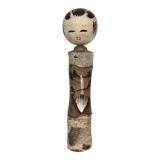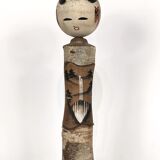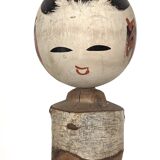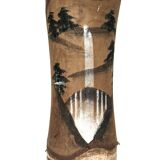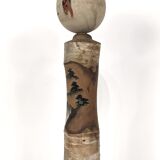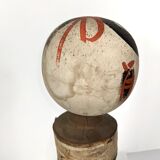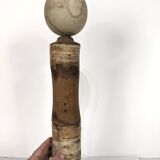Kokeshi with Nô face theater Japan 1950-60
🙈 Oops, this product is already sold or unavailable. Discover our 1500 new products or products similar to this item !
- Dimensions :
- H46 x W11 x D11
- Color :
- wooden
- Material :
- wood
- Style :
- ethnic
These were travel souvenirs (omiyage), which appeared after the second world war. Produced until the end of the 60s. Fast bill, their décor is often linked to a thermal spring. Excerpts from poems decorate them. Usually anonymous; they were made by well-known craftsmen but under an assumed trade name. This made it possible to free oneself from stylistic corporate norms. There were large workshops among others in tohoku, okinawa. The setting could be chosen by the local retailer according to tourist needs: for example mount fuji, waterfall with bridge... There are many subgroups: scenes of life (bath, babysitting, geisha, lovers...) - kappas deities, tanukis... This copy belongs to the "woody omiyage": the bark is partially preserved, creating a space to decorate. A special treatment fixed the bark so that it would not come off in time. Wear, shocks. Traces of moisture on the back of the head, small spots. ----- about kokeshis kokeshi appear in the years 1820-40 (end of the edo period). Originally, they were made from scraps of wood by artisans and peasants and sold to the people of the city. The oldest have a keel shape and may have a movable head with red in dominant color. They are originally made of wood (cherry, pear, maple). They were toys for girls, or offered as a token of love or friendship; or symbolized the desire to have a healthy child. The doll comes from a shinto communion with nature (forest / wood / landscape). Shinto places links between landscapes and feminine forms. They are, modesty, discretion, femininity, feminine ideal. A detailed explanation of the art of kokeshis will be given to the purchaser.- omiyage -.
5 ()
Our suggestion of similar items
Discover more similar items